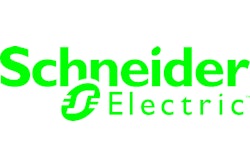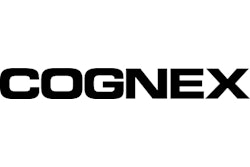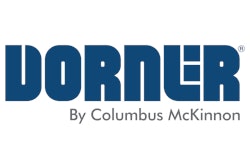It’s a horizontal case packer for doing a stand-up pack pattern with
pillow style bags or standup pouches. It’s a vertical case packer,
too. But most surprising of all, it’s a case packer that uses 3-axis
delta robots. And that’s unheard of, especially for horizontal case
packing.
Like no case packer you’ve ever seen
In fact, it’s like no case packer you’ve ever seen, designed for extreme versatility. In the configuration on the floor at Pro Pack Systems’ Salinas, California, plant at the time of this writing, it’s a machine capable of running up to 4 3-axis delta robots to pack 2 columns of 6 bags in a display case and 60 vend packs in a lay-flat pattern in a larger bulk case.
Key to the design is a combination of commercially available, best-of-breed subsystems, Pro Pack’s patent-pending end effector concept, simple mechanics and sophisticated yet simple software.
Pro Pack (PACK EXPO 2008 booth N-4457) president Dave Zurlinden is ready to apply the same design principles to an endless variety of customer requirements.
Here’s how it works, beginning with the display case.
Horizontal packing
“If you take a lot of lay-flat products and tilt the case, you have head room that you can get the end effector into. That’s the trick,” Zurlinden explains. “Tilting the case also lets you build columns without spilling. When the case is turned and the bags settle, they fill up the case nicely, making a good shelf display.”
This is the horizontal packing function. The end effector has a low profile compared to elastomeric grippers and is overhung on the tool center point, thus allowing it to fit inside the tilted case. It is vacuum actuated and each arm can pick up to 80 individual bags per minute.
Because the display case goes from shipper to point-of-sale, graphics on the bags must face forward and right side up. The bags arrive from the upstream form/fill/seal machines in approximate orientation, and a fourth servo axis on each robot pivots the end effector to make the final adjustments.
A standup pouch (flat bottom or doyen) of the right dimension can also be packed horizontally, using the tilted case to stabilize the stack.
Vertical packing
“In the vertical packing application,” Zurlinden continues, “the delta 3 has enough reach over the case for products that can tolerate some drop. In this application, the pack pattern is random.”
A different configuration could provide more reach into a case if needed, for example one using a delta with a smaller diameter work envelope and therefore greater reach combined with a narrower product conveyor that would consume less of the arm’s travel capacity to reach the case conveyor.
The machine is designed to have great application latitude with mechanical simplicity. For example, a single flighted belt is sized for the larger case. When running the smaller cases, a guide rail is swung into place to assure the case is aligned with the rear cleat of a given pocket.
Off-the-shelf subsystems save packagers time and money
Pro Pack consciously builds with industry-leading, off-the-shelf subassemblies – ELAU robot arms, Dorner conveyors and Cognex vision systems – for short lead times, maximum standardization and an absolute minimum of custom-made change parts.
In fact, the only change parts in this particular application are the grippers, which are one of Pro Pack’s innovations and a prime advantage of the system.
The few other changeover steps are made without parts or carts, just hard stops and pins on the case guide rails and a single hand wheel on the case conveyor to adjust tilt angle or level the belt for top loading. The top rail for the larger case swings out of the way, and the rail that secures the side (when top loading) or top (when side loading) of the case simply moves from one stop to the other.
Except for the handwheel, these adjustments are either/or movements requiring no measurements. No tools or special skills are required.
Software engineering does the heavy lifting
Industry experts have cited software as the dominant trend in packaging machinery design, and it is the heart of the Pro Pack system’s performance. And yet, the Pro Pack program is not at all complex.
That’s because a single software object running in the ELAU controllers manages all critical aspects of communicating real-time product location, orientation, which robot to pick what product and where to pack it, when to index cases and when to hand off packing of partially filled cases to the next robot.
It’s also a direct result of the engineering partnership between Schneider Electric’s ELAU packaging solutions (PACK EXPO booth E-6413), whose specialists have largely defined modular software best practices for the packaging industry. Pro Pack’s automation controls specialist, Paul Zurlinden, clearly believes in ELAU’s modular, standards-based software -- he serves as one of two packaging machinery providers on the OMAC Packaging Workgroup’s executive committee.
You do not see rows of photoeyes or limit switches on the machine, only vision at the infeed side of the product conveyor and an encoder to track belt speed. Instead, the controller’s processor architecture and software environment are powerful enough to calculate and command at least 300 motions per minute from the vision and encoder inputs.
In operation, the downstream robot determines when the case conveyor indexes – as soon as it has finished packing its three cases. If the upstream six cases are not completed, they are indexed anyway and the downstream robots finish the job while the upstream robot gets 3 empty cases.
Likewise, the software determines which arms grab which bags, based on the vision systems. It’s all a highly dynamic, software driven environment with minimal mechanical intervention and a product conveyor that doesn’t stop. There is no accumulation for product waiting for each robot to complete its task. And unlike less sophisticated multi-robot installations of the past, the upstream robots are not typically overworked and the downstream robots are not often idle.
Each robot can pick 80 packs per minute. This particular unit has 3 robots and room to add a fourth. The belt currently runs 2 rows of product past 2 cameras, but is sufficiently wide to accommodate 4, 5 or even 6 rows of product and additional cameras. More bags could be ganged up and the belt simply run at a slower speed.
Also of interest are locking door latches – guard doors cannot be opened until the machine is shut down. This also means that the doors cannot be used as an e-stop to circumvent normal shutdown procedures.
Pro Pack Systems’ complete solution includes its new EBS HS high speed case printer, erector and bottom sealer to keep the packer supplied with up to 30 printed and erected cases per minute, and a line of top sealers to keep pace with the new packer’s output.
About Pro Pack Systems
Pro Pack Systems, Inc. has been located in Salinas, California, since 1992. From extensive packaging and automation experience in the food and wine industries, Pro Pack is well equipped to design and build custom solutions to packaging challenges, from individual packaging line components to full integration projects.
www.propacksystems.com
About ELAU packaging solutions
ELAU, Schneider Electric’s packaging specialist, equips over $1 billion worth of packaging machines annually. Currently, over 40,000 purpose-built ELAU packaging automation systems are deployed in machinery worldwide.
Through ELAU, Schneider Electric is the only controls supplier with a dedicated business unit focused exclusively on the automation of packaging machinery.
The market demands packaging operations that are more flexible, efficient and sustainable to fulfill marketing, supply chain and global business strategies. ELAU innovations have enabled a revolution in mechanical, software and hardware modularity to deliver these agile packaging systems.
For more information, visit www.elau.com or email [email protected].
Like no case packer you’ve ever seen
In fact, it’s like no case packer you’ve ever seen, designed for extreme versatility. In the configuration on the floor at Pro Pack Systems’ Salinas, California, plant at the time of this writing, it’s a machine capable of running up to 4 3-axis delta robots to pack 2 columns of 6 bags in a display case and 60 vend packs in a lay-flat pattern in a larger bulk case.
Key to the design is a combination of commercially available, best-of-breed subsystems, Pro Pack’s patent-pending end effector concept, simple mechanics and sophisticated yet simple software.
Pro Pack (PACK EXPO 2008 booth N-4457) president Dave Zurlinden is ready to apply the same design principles to an endless variety of customer requirements.
Here’s how it works, beginning with the display case.
Horizontal packing
“If you take a lot of lay-flat products and tilt the case, you have head room that you can get the end effector into. That’s the trick,” Zurlinden explains. “Tilting the case also lets you build columns without spilling. When the case is turned and the bags settle, they fill up the case nicely, making a good shelf display.”
This is the horizontal packing function. The end effector has a low profile compared to elastomeric grippers and is overhung on the tool center point, thus allowing it to fit inside the tilted case. It is vacuum actuated and each arm can pick up to 80 individual bags per minute.
Because the display case goes from shipper to point-of-sale, graphics on the bags must face forward and right side up. The bags arrive from the upstream form/fill/seal machines in approximate orientation, and a fourth servo axis on each robot pivots the end effector to make the final adjustments.
A standup pouch (flat bottom or doyen) of the right dimension can also be packed horizontally, using the tilted case to stabilize the stack.
Vertical packing
“In the vertical packing application,” Zurlinden continues, “the delta 3 has enough reach over the case for products that can tolerate some drop. In this application, the pack pattern is random.”
A different configuration could provide more reach into a case if needed, for example one using a delta with a smaller diameter work envelope and therefore greater reach combined with a narrower product conveyor that would consume less of the arm’s travel capacity to reach the case conveyor.
The machine is designed to have great application latitude with mechanical simplicity. For example, a single flighted belt is sized for the larger case. When running the smaller cases, a guide rail is swung into place to assure the case is aligned with the rear cleat of a given pocket.
Off-the-shelf subsystems save packagers time and money
Pro Pack consciously builds with industry-leading, off-the-shelf subassemblies – ELAU robot arms, Dorner conveyors and Cognex vision systems – for short lead times, maximum standardization and an absolute minimum of custom-made change parts.
In fact, the only change parts in this particular application are the grippers, which are one of Pro Pack’s innovations and a prime advantage of the system.
The few other changeover steps are made without parts or carts, just hard stops and pins on the case guide rails and a single hand wheel on the case conveyor to adjust tilt angle or level the belt for top loading. The top rail for the larger case swings out of the way, and the rail that secures the side (when top loading) or top (when side loading) of the case simply moves from one stop to the other.
Except for the handwheel, these adjustments are either/or movements requiring no measurements. No tools or special skills are required.
Software engineering does the heavy lifting
Industry experts have cited software as the dominant trend in packaging machinery design, and it is the heart of the Pro Pack system’s performance. And yet, the Pro Pack program is not at all complex.
That’s because a single software object running in the ELAU controllers manages all critical aspects of communicating real-time product location, orientation, which robot to pick what product and where to pack it, when to index cases and when to hand off packing of partially filled cases to the next robot.
It’s also a direct result of the engineering partnership between Schneider Electric’s ELAU packaging solutions (PACK EXPO booth E-6413), whose specialists have largely defined modular software best practices for the packaging industry. Pro Pack’s automation controls specialist, Paul Zurlinden, clearly believes in ELAU’s modular, standards-based software -- he serves as one of two packaging machinery providers on the OMAC Packaging Workgroup’s executive committee.
You do not see rows of photoeyes or limit switches on the machine, only vision at the infeed side of the product conveyor and an encoder to track belt speed. Instead, the controller’s processor architecture and software environment are powerful enough to calculate and command at least 300 motions per minute from the vision and encoder inputs.
In operation, the downstream robot determines when the case conveyor indexes – as soon as it has finished packing its three cases. If the upstream six cases are not completed, they are indexed anyway and the downstream robots finish the job while the upstream robot gets 3 empty cases.
Likewise, the software determines which arms grab which bags, based on the vision systems. It’s all a highly dynamic, software driven environment with minimal mechanical intervention and a product conveyor that doesn’t stop. There is no accumulation for product waiting for each robot to complete its task. And unlike less sophisticated multi-robot installations of the past, the upstream robots are not typically overworked and the downstream robots are not often idle.
Each robot can pick 80 packs per minute. This particular unit has 3 robots and room to add a fourth. The belt currently runs 2 rows of product past 2 cameras, but is sufficiently wide to accommodate 4, 5 or even 6 rows of product and additional cameras. More bags could be ganged up and the belt simply run at a slower speed.
Also of interest are locking door latches – guard doors cannot be opened until the machine is shut down. This also means that the doors cannot be used as an e-stop to circumvent normal shutdown procedures.
Pro Pack Systems’ complete solution includes its new EBS HS high speed case printer, erector and bottom sealer to keep the packer supplied with up to 30 printed and erected cases per minute, and a line of top sealers to keep pace with the new packer’s output.
About Pro Pack Systems
Pro Pack Systems, Inc. has been located in Salinas, California, since 1992. From extensive packaging and automation experience in the food and wine industries, Pro Pack is well equipped to design and build custom solutions to packaging challenges, from individual packaging line components to full integration projects.
www.propacksystems.com
About ELAU packaging solutions
ELAU, Schneider Electric’s packaging specialist, equips over $1 billion worth of packaging machines annually. Currently, over 40,000 purpose-built ELAU packaging automation systems are deployed in machinery worldwide.
Through ELAU, Schneider Electric is the only controls supplier with a dedicated business unit focused exclusively on the automation of packaging machinery.
The market demands packaging operations that are more flexible, efficient and sustainable to fulfill marketing, supply chain and global business strategies. ELAU innovations have enabled a revolution in mechanical, software and hardware modularity to deliver these agile packaging systems.
For more information, visit www.elau.com or email [email protected].
Companies in this video
Videos from Dorner





























